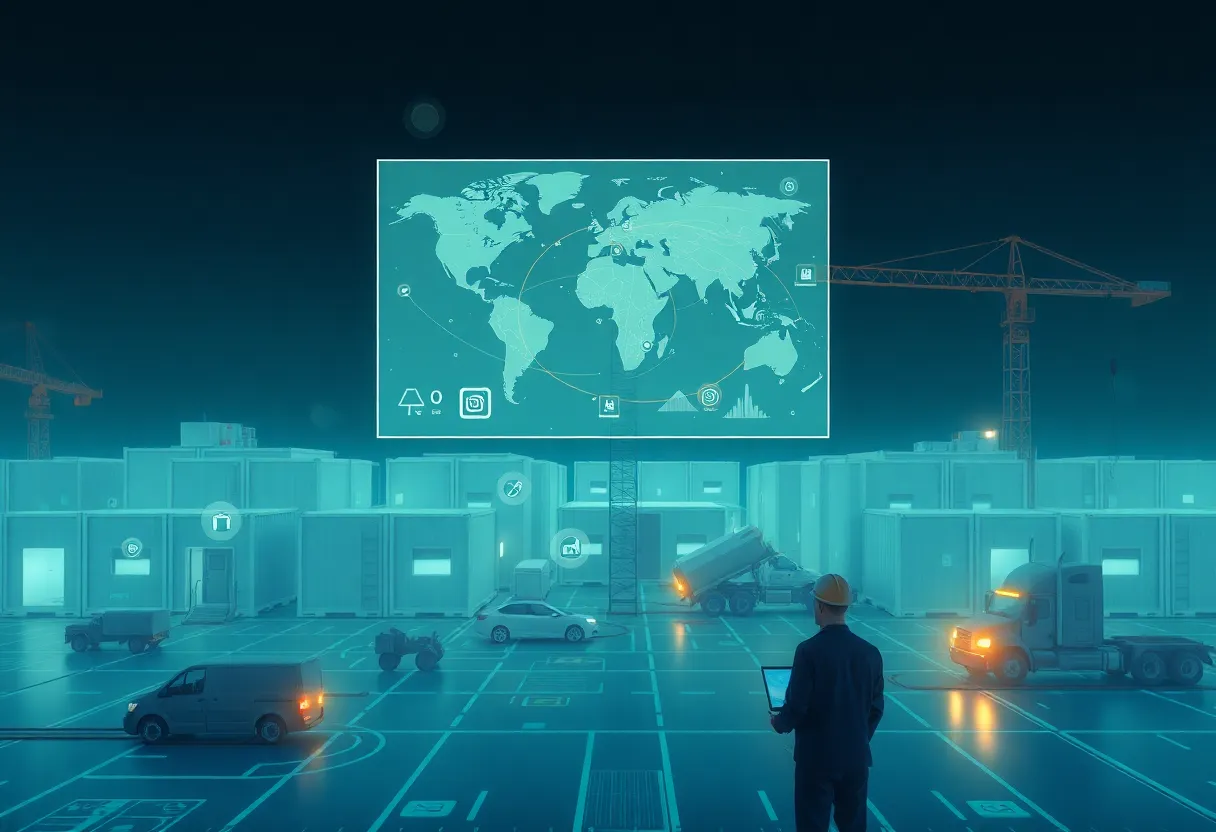Ansan, South Korea, August 19, 2025
News Summary
A research team at Hanyang University ERICA developed a digital twin–enabled facility management system (DT-FMS) to improve tracking, management and reuse of relocatable modular buildings. The platform integrates BIM, IoT sensors and GIS to create a real-time virtual model that supports monitoring, logistics and decision support across three layers: physical, digital and service. Tested on a relocatable modular school in South Korea, the framework improved module distribution, reuse and operational efficiency. Researchers say the approach can support circular construction by extending component life, though wider adoption needs data standards, sensor investment and manager training.
Hanyang University ERICA unveils digital‑twin framework to manage relocatable modular buildings across their full lifecycle
A research team from Hanyang University ERICA has published a new digital‑twin facility management framework designed to improve how relocatable modular buildings (RMBs) are tracked, reused and moved between sites. The framework aims to support a more circular approach to modular construction by linking physical modules to live virtual models and decision tools that cover the entire building life cycle.
Key takeaway
The new system, called a digital twin–enabled facility management system (DT‑FMS), combines Building Information Modeling (BIM), Internet of Things (IoT) sensors and Geographic Information Systems (GIS) to enable 3D modelling, sensor‑based monitoring and location‑aware logistics planning. The team’s case study on a relocatable modular school in South Korea showed measurable gains in module distribution, reuse and management efficiency, with associated reductions in operational costs and energy use.
What the framework does and why it matters
Relocatable modular buildings are built from prefabricated units that can be assembled, taken apart and transported to new sites. That flexibility reduces upfront cost and environmental impacts compared with many conventional builds, but it also creates a practical problem: keeping track of modular units, their condition, where they have been used and how best to reuse them.
The DT‑FMS addresses that challenge by creating a tight link between the physical asset and a real‑time virtual replica. That link supports ongoing condition monitoring, predictive analysis and logistics decisions such as where to deploy a unit next, when to refurbish components, and when reuse is no longer viable. These capabilities are intended to help operators make economically and environmentally smarter choices across many reuse cycles.
How the system is built
The framework is organised into three layers:
- Physical layer: sensors, tags and people on site that gather data from modules and communicate status to the digital layer.
- Digital layer: BIM models, integrated data stores and analytics engines that create and update the virtual replica and run condition and lifecycle algorithms.
- Service layer: interfaces and decision tools that allow facility managers and stakeholders to monitor, control and plan actions across a module’s life.
Combining BIM, IoT and GIS gives the system 3D modelling for component geometry, sensor feeds for real‑time condition data, and location data for logistics and site planning. Together, these elements support both day‑to‑day operations and longer term reuse strategies.
Research, validation and publication
The research was led by Associate Professor Yonghan Ahn and the team published the framework earlier in the month in a peer‑reviewed construction automation journal. The project included a case study of a relocatable modular school system in South Korea that tested the framework’s practical performance. The case showed improvements in distribution and reuse planning that translated into lower operational costs and improved energy efficiency.
Implications for a circular construction model
The research team positions the DT‑FMS as a tool to support circular economy goals in construction. By improving visibility into each module’s condition, location and history, the system makes reuse and reconfiguration more predictable and cost‑effective, reducing waste and increasing value captured over many lifecycles. The team also notes that digital twin approaches are already expanding in other industries but have been underused in modular construction to date.
Limitations and next steps
While the case study results are promising, the researchers highlight implementation hurdles that remain. These include standards for data formats between manufacturers and operators, upfront costs for sensor and tagging systems, and organisational shifts needed to treat modules as long‑lived assets rather than single‑use units. Wider field trials, interoperability work across suppliers and pilot projects with different module types are listed as logical next steps to validate scalability.
Who led the work
The project was led by an academic team at Hanyang University ERICA and included co‑authors who emphasise the framework’s potential to reduce waste and make modular use more efficient. The research appears in a recognised engineering journal where full technical details and data are available for peer review and adoption.
Practical takeaway for builders and asset managers
For organisations using or planning relocatable modular buildings, the DT‑FMS approach points to three practical steps: add unique digital identity and sensor tracking to modules, integrate BIM and GIS for combined geometric and location context, and use analytics to plan reuse and relocation based on condition and demand. Taken together, these steps can lower operating costs, reduce energy use and extend the useful life of modular assets.
FAQ
What is a digital twin in this context?
A digital twin is a live virtual model of a physical module that receives data from sensors and systems to mirror the module’s condition, location and usage over time.
How does DT‑FMS differ from traditional facility management?
DT‑FMS links BIM, IoT and GIS to provide continuous, location‑aware modelling and analytics for modules that are moved between sites, rather than fixed buildings that stay in one place.
Which building types benefit most from this framework?
Relocatable modular buildings such as temporary schools, field offices and modular housing are primary targets, but any prefabricated asset that moves or is reused can benefit.
Does the framework require new hardware?
Sensors, unique IDs and connectivity are needed to feed the digital twin. Existing BIM models and GIS data can be reused, but some investment in tags and IoT devices is typically required.
Will this reduce waste?
By enabling planned reuse and better condition‑based repairs, the framework is designed to minimise waste and improve resource efficiency across multiple lifecycles.
Key features at a glance
| Feature | Purpose | Benefit |
|---|---|---|
| DT‑FMS | Integrates physical assets with virtual models | Real‑time monitoring and lifecycle decision support |
| BIM + IoT + GIS | Provides geometry, condition data and location context | Improved planning, tracking and logistics |
| Three‑layer architecture | Separates physical, digital and service concerns | Clear roles for data collection, analytics and use |
| Case study: modular school | Field validation of distribution and reuse strategies | Lower operational costs and improved energy efficiency |
| Circular economy focus | Enables reuse, reconfiguration and optimal relocation | Reduced waste and higher value across lifecycles |
Deeper Dive: News & Info About This Topic
Additional Resources
- KoreaTechDesk: E8 – Leading Korea’s digital-twin revolution with deep-tech innovation
- Wikipedia: Digital twin
- GIM International: Seoul Metropolitan Government collaborates on hyper-realistic digital twin project
- Google Search: relocatable modular building
- DroneLife: A model of Korea — the ambitious project to make a digital twin of a country
- Google Scholar: digital twin modular construction
- GeoWeek: Techtree Innovation & Seoul government digital twin project for urban safety services
- Encyclopedia Britannica: modular construction
- PR Newswire: LG Innotek collaborates to drive its digital-twin technology
- Google News: digital twin modular building South Korea
Author: Construction CA News
The CALIFORNIA STAFF WRITER represents the experienced team at constructioncanews.com, your go-to source for actionable local news and information in California and beyond. Specializing in "news you can use," we cover essential topics like product reviews for personal and business needs, local business directories, politics, real estate trends, neighborhood insights, and state news affecting the area—with deep expertise drawn from years of dedicated reporting and strong community input, including local press releases and business updates. We deliver top reporting on high-value events such as the Rose Parade, Coachella, Comic-Con, and the California State Fair. Our coverage extends to key organizations like the California Building Industry Association and Associated General Contractors of California, plus leading businesses in technology and entertainment that power the local economy such as Apple and Alphabet. As part of the broader network, including constructionnynews.com, constructiontxnews.com, and constructionflnews.com, we provide comprehensive, credible insights into the dynamic landscape across multiple states.




